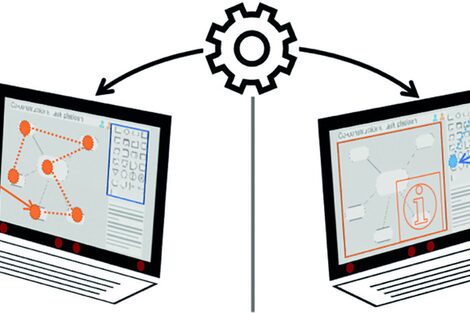
Computer-mediated collaboration lacks non-verbal cues that are an essential part of collaborative group work, such as gaze tracking. The research area of "Gaze Sharing" aims to compensate for this disadvantage by recording the eye movements of users in order to visualize them in the workspace of the cooperation partners. This increases the joint attention of a group and can be crucial for the efficiency of collaboration. However, the visual overlay of eye movements on a groupware requires the use of strict WYSIWIS (What-You-See-Is-What-I-See) user interfaces and is considered a distracting visualization even for the eye movements of a single user. However, groups instead of dyads and WYSIWIS user interfaces that are not consistently implemented are common in computer-mediated collaboration and therefore make the use of this display method even more difficult. One possible approach is to capture the current context, such as features of the task, the current proximity of the collaboration, or patterns of eye movements, to display concise representations of visual attention (see Figure 1), which are then not affected by the aforementioned limitations of conventional overlay visualizations. For the design and evaluation of concise gaze sharing representations, the aim of Christian Schlösser's dissertation was to propose a design-oriented procedural model and to evaluate it by applying it in three case studies. Relevant design knowledge for "Gaze Sharing" in groupware was also derived from these case studies.
Christian Schlösser successfully defended his dissertation in December 2019. The doctorate was carried out in cooperation with Prof. Dr.-Ing. Jörg M. Haake from the FernUniversität in Hagen. At the time of printing this report, the dissertation was in the process of being published in the online library of the FernUniversität Hagen.
After training as an IT specialist in the field of "application development", Christian Schlösser first studied business informatics at Fachhochschule Dortmund, graduating with a Bachelor of Science degree, and then switched to the joint master's degree program in business informatics at TH Köln and Fachhochschule Dortmund.
At the beginning of his studies, he worked as a student and research assistant and, after completing his Master's degree, as a research assistant in various (third-party funded) research projects under the supervision of Prof. Dr. Andrea Kienle.
Appraiser
- Prof. Dr.-Ing. Jörg M. Haake (Fakultät für Mathematik und Informatik, FernUni Hagen)
- Prof. Dr. Andrea Kienle (IDiAL, Fachhochschule Dortmund)
